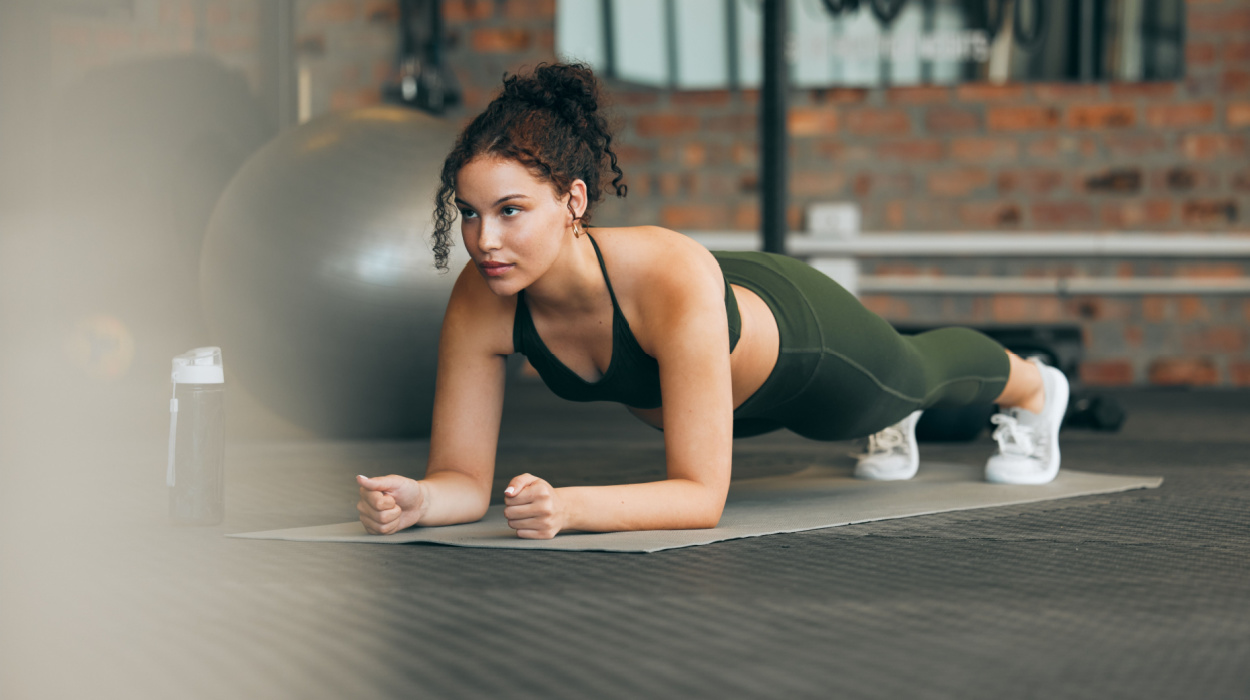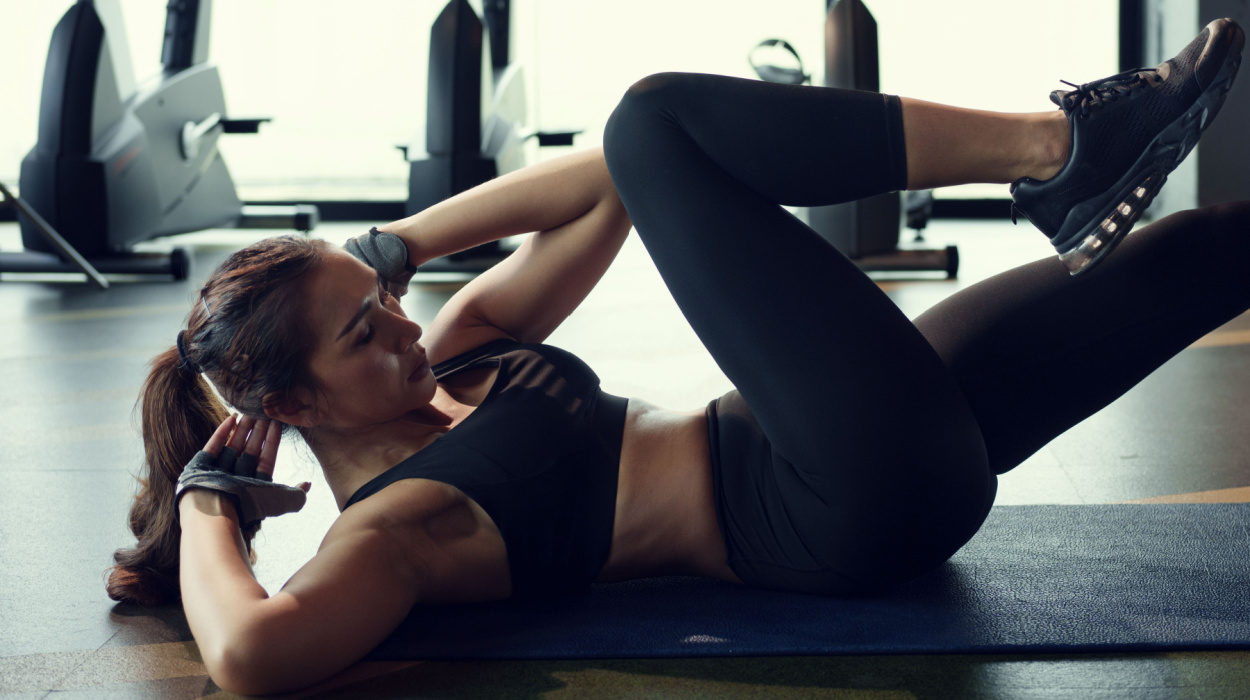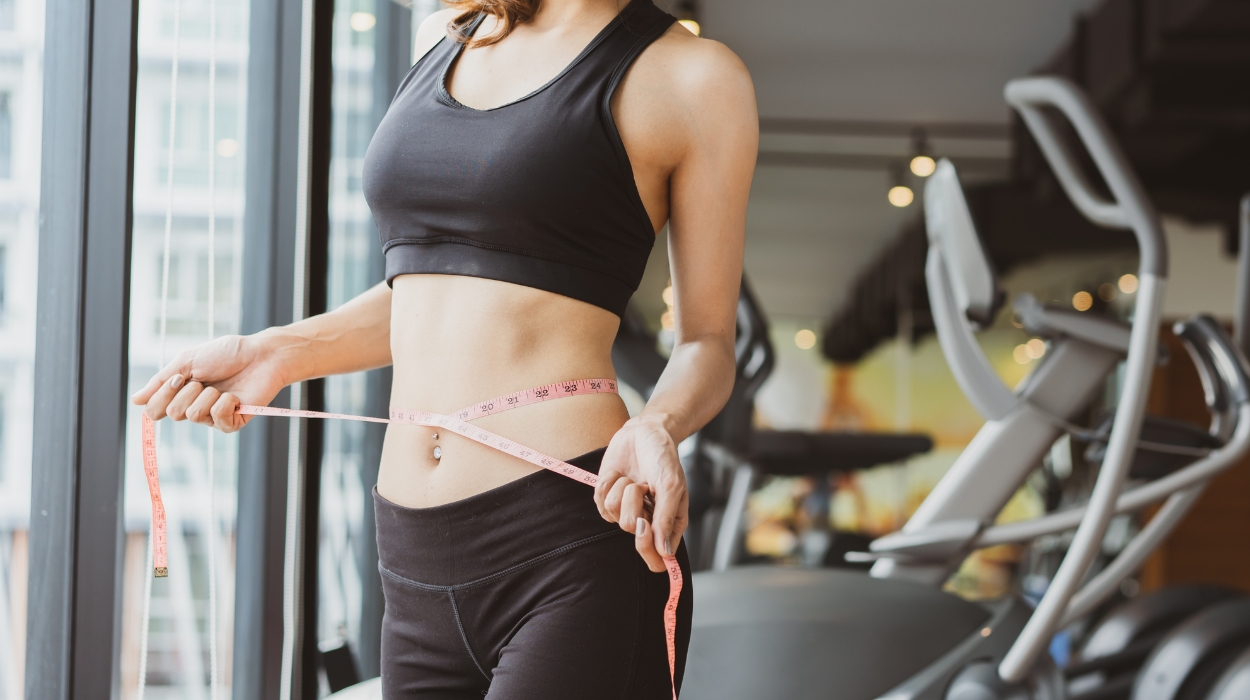Flat stomachs are a well-established beauty standard in many parts of the world, but very few people have washboard abs so often seen on social media. A little abdominal fat is a natural feature of most healthy bodies and helps to protect your internal organs. However, too much belly fat can be dangerous.
Research has found[1] a link between excess abdominal fat and an increased risk of early death. Having too much belly fat increases the risk of obesity-related health conditions[2] such as type 2 diabetes, heart disease, and high blood pressure.
Slimming down your waistline can improve your likelihood of living a longer, healthier life. Read on to learn how to lose belly fat at the gym.
How To Lose Belly Fat Fast At The Gym
- Cardiovascular Exercise
- Planks
- Mountain Climbers
- Crunches
- Russian Twists
- Deadlifts
- Squats
- Stationary Cycling
- Flutter Kicks
- Rowing Machine
10 Exercises To Lose Belly Fat At The Gym
Excess fat in the upper body raises the risk of serious health conditions, regardless of overall body fat percentage. A waist circumference[3] of over 40 inches in men and 35 inches in non-pregnant women is considered dangerous as it is associated with higher risks of heart disease, type 2 diabetes, and cancer.
Fortunately, the negative effects of excess belly fat are reversible through weight loss. You can lose belly fat at the gym with cardiovascular exercises and workouts that target and strengthen your abdominal muscles. It is difficult to sport reduce belly fat, but exercises that engage the core can help to firm and tone your stomach.
Cardiovascular Exercise
Being overweight increases the amount of subcutaneous and visceral fat in your whole body. Cardiovascular training is an effective form of exercise for weight loss[4] and, when combined with a balanced diet, can help you shed body fat quickly.
The best cardio workout may depend on your fitness level and exercise preference. Gym equipment such as the treadmill, elliptical trainer, and rowing machine can all get your heart pumping and burn calories.
Planks

Planks are a strength training exercise that activates the back, arm, glute, and core muscles. Practicing the plank position can build muscle in your abdominal area, helping to tone your belly and reduce unwanted fat.
In a plank position, your weight is supported by your forearms and toes. The arms should be bent at a 90-degree angle, with your shoulders directly above your elbows, and your heels over your toes. Hold the position by keeping your legs and torso straight and your shoulders down.
Planking may look easy, but this position engages[5] multiple muscle groups at once and is hard to maintain. You may only be able to hold the position for 10–20 seconds on your first try. However, if you practice the plank regularly, your strength and stamina will improve which will result in holding the position for a longer period of time.
Mountain Climbers
Mountain climbers are a type of cardiovascular exercise that also engages your core muscles. Therefore, they have the dual benefit of burning calories and strengthening your abdominal muscles, helping to melt excess belly fat.
First, get into a plank position. Next, pull your right knee in toward your chest, while keeping your right foot off the ground. Straighten the leg to return to the plank position, then immediately repeat the movement with your left leg.
Switch from one leg to the other, for a minute. If a full minute is too tiring, start with 10 repetitions and increase the duration of the mountain climber exercises as your strength and fitness improve.
Crunches

Crunch exercises target the rectus abdominis[6] (the muscles responsible for a six-pack) and obliques (the muscles that run down either side of your waist). Including abdominal crunches in your workout routine tones the muscles in your waist and belly, creating a more sculpted physique and helping to burn belly fat.
To perform a crunch, start by lying on your back with knees bent and feet planted hip-distance apart. Cross your arms over your chest with your palms just below your shoulders, and inhale as you engage your abs. Next, lift your upper body off the floor as you exhale, keeping your head and neck relaxed.
Russian Twists
Russian twists are an effective core workout that activates the obliques, hips, and shoulder muscles. When performed regularly, they can strengthen and tone the core, helping to shift stubborn belly fat and improve your overall fitness.
To do a Russian twist, first, sit down with your sit bones firmly rooted to the floor. Raise your feet off the ground, keeping your knees bent and your trunk and spine straight. Next, interlace your fingers in front of your body and use your abdominal muscles to twist your upper body from one side to the other.
To increase the difficulty, hold a dumbbell or medicine ball as you perform your Russian twists.
Deadlifts
Deadlifts are a weight-training exercise that targets multiple muscle groups at once. Deadlift exercises predominantly build muscle mass in the lower body,[7] but they also strengthen the core, back, and trapezius muscles.
You will need a barbell to perform deadlifts. If you’re not used to lifting weights, consider starting with a lower weight.
First, position your feet shoulder-width apart with the bar on the floor in front of you. Your feet should be pointing forward with your toes under the bar.
Squat to grasp the bar and use your legs to lift it. The bar should remain close to your shins as you lift and come to rest against your thighs when you are standing. Engage your abdominal muscles and keep your back straight as you lift the barbell.
Squats
Like deadlifts, squats engage muscles in both the upper and lower body.[8] They’re an effective exercise to increase overall strength and build muscles. Adding squats to a workout routine can help sculpt and define your core and lower body.
You can perform squats with or without added weights. If you’re new to the exercise, practice the movement without weights first. Once you have perfected your squatting technique, you can add weights to increase the difficulty of the workout and build more muscle.
To do a squat, stand with your feet shoulder-width apart and your toes pointing forward. From here, slowly bend your knees and push your hips back and down until your thighs are parallel to the floor. Pause here for a moment before slowly straightening your legs until you are back to your starting position.
Stationary Cycling
Stationary bicycles are found in most gyms and can be used to add cardio to your workout routine. Cycling is a type of vigorous cardiovascular exercise[9] that can burn fat, build stamina, and improve heart health. Cardio workouts burn lots of calories and can slim down your entire body, including your belly.
To use a stationary bicycle effectively, keep your core engaged and your back straight as you pedal. Hold your head up and avoid leaning on the handlebars, as this puts stress on your wrists and reduces the benefits of pedaling on your lower body.
Flutter Kicks
Flutter kicks are another option to help tone the lower abs and can help shift stubborn belly fat. They also engage the hip flexors, glutes, and quads, helping to build lower body strength and increase overall muscle mass.
Flutter kicks are easy to perform. Start by lying on your back, with your head and shoulders slightly lifted off the ground. Raise your legs to a 45-degree angle and kick them up and down with an alternating movement. Continue fluttering for as long as you can. Aim for 90 seconds, but take rests as needed.
Rowing machine
Rowing is a full-body exercise that can improve both cardiovascular fitness and muscle strength.[10] Using the rowing machine at your gym activates multiple muscle groups and burns calories, helping you to lose weight and tone up. Over time, this can reduce belly fat and boost your stamina and fitness.
How You Can Optimize Fat Loss
Regular cardio is key for improving fitness, but weight training can also help your body burn fat. Weight training changes your body composition by reducing fat tissue and building muscle, and muscle cells burn more calories than fat cells.[11] Therefore, increasing muscle mass can boost metabolism, allowing your body to burn more calories.
Another critical aspect of weight loss is diet management. Your body should be in a calorie deficit to decrease weight, meaning you’re burning more calories than you’re taking in. However, working out how many calories your body needs to function healthily while losing fat can be confusing.
Consuming too many calories can negate the hard work you put in at the gym, but eating too little can leave you feeling lackluster and make it harder to exercise. So, the key question is; how much calorie deficit is recommended for healthy weight loss?
How To Optimize Your Diet For Fat Loss
Slow and steady weight loss is the most sustainable, so most people should aim to shed one or two pounds of fat per week. To achieve this, you need to maintain a calorie deficit of 500–1,000 calories per week.[12] Many people can easily cut unnecessary calories from their diet by avoiding processed foods, which are typically high in saturated fat and sugar.
A balanced diet that emphasizes vegetables, fruits, whole grains, and healthy fats is an integral part of a healthy lifestyle. The best meat for weight loss is lean cuts of beef, poultry, pork, lamb, and fish. However, this doesn’t mean you should avoid oily fish (like salmon, tuna, and mackerel), as these are excellent sources of omega-3 fatty acids[13] and may help to raise your metabolic rate.[14]
If you’re still struggling to drop excess pounds, weight loss supplements can help. Diet pills
work by suppressing your appetite and elevating your energy levels, which can make it easier to work out and reduce your urge to snack on unhealthy foods. You should consult with a doctor or nutritionist before making major changes to your diet or starting a supplement.
How Long Does It Take To Lose Belly Fat At The Gym
Many people want to know how to cut belly fat fast at the gym, but every fitness journey is unique. If you’re a bit overweight, you may start to see results within a few weeks. However, people with a lot of weight to lose may feel that the process can be painfully slow.
Consider hiring a certified personal trainer to help you stay on track with your new fitness regime. A personal trainer can formulate a fitness program tailored to your specific needs and weight loss goals. They can also keep you motivated and offer guidance to help you achieve your fitness goals more quickly.
How Much Cardio Should You Do At The Gym To Lose Belly Fat
An effective type of workout for fat loss is high-intensity cardiovascular exercise. High-intensity interval training, also referred to as HIIT, is particularly effective for weight loss[15] and improving cardiovascular fitness. HIIT training involves short bouts of intense cardio exercise interspersed with brief rest periods.
However, if HIIT isn’t your thing, any level of cardio exercise is helpful. You can try running, jogging, swimming, rowing, or cycling at your own pace to help you lose weight and burn belly fat.
Cardio is great for burning calories and improving heart health. It’s one of the most efficient ways to shed excess weight, but how much cardio should you do to lose belly fat at the gym?
Healthcare professionals recommend[16] that adults aim for at least 150 minutes, or five 30-minute workout sessions per week of moderate-intensity exercise. Moderate-intensity exercise[17] is physical activity that raises your heart rate to about 70% of your maximum heart rate.
For even greater health benefits, you can also add 75 minutes of vigorous-intensity exercise like jogging or running every week. Vigorous intensity exercise is any aerobic exercise that boosts your heart rate to above 80% of its maximum rate.
Regular cardio not only helps with weight loss; it also strengthens your heart[18] and muscles, boosts stamina, improves lung function, benefits mental health, and reduces your risk of heart disease.
At the end of the day, any cardio is better than no cardio. Workout plans should be individualized to your needs and goals. You can start increasing the intensity, duration, or frequency as you track your progress and see improvements to your fitness level.
Conclusion
Being overweight or obese puts you at risk of numerous health conditions. Belly fat, in particular, is strongly associated with increased risk of early death. Fortunately, you can minimize this risk at the gym with regular cardiovascular exercise and weight training.
Cardio burns calories and can help you reduce your overall body fat percentage, while weight training builds muscle and boosts metabolism. When combined with a healthy diet, exercise can melt fat from your belly and help you achieve a better body and lifestyle.
Frequently Asked Questions
It’s not possible to specifically target stomach fat, but you can reduce belly fat by lowering your overall body fat percentage. You can burn calories and lose weight with cardiovascular exercises.
Weight loss varies between individuals and is affected by a variety of factors, including your workout regimen. Cardio is considered effective for burning fat, so focus on machines designed for cardio activity like treadmills, rowing machines, and stationary bicycles.
In general, losing weight and burning fat takes hard work. How an individual loses fat depends on many factors, and different people will lose belly fat at different rates and to varying degrees of success.
There are many possible reasons why your exercise and diet regimen aren’t working. Hormonal imbalances, genetic factors, and various other medical conditions may all inhibit weight loss at the gym.
 Evidence Based
Evidence Based
